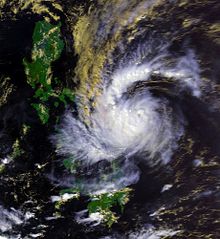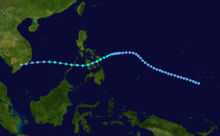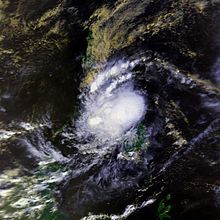- Tropical Storm Thelma
-
This article is about the 1991 tropical storm in the Philippines. For other storms of the same name, see Tropical Storm Thelma (disambiguation).
Tropical Storm Thelma Tropical storm (JMA) Tropical storm (SSHS) 
Tropical Storm Thelma nearing the Philippines on November 4 Formed November 1, 1991 Dissipated November 8, 1991 Highest winds 10-minute sustained:
75 km/h (45 mph)
1-minute sustained:
85 km/h (50 mph)Lowest pressure 992 mbar (hPa; 29.29 inHg) Fatalities 5,101-8,000+ direct Damage $19 million (1991 USD) Areas affected Philippines, Vietnam Part of the 1991 Pacific typhoon season Tropical Storm Thelma (international designation: 9125, JTWC designation: 27W, Philippine name: Uring) was the deadliest tropical storm of the 1991 Pacific typhoon season, killing between 5,101 to 8,100 people as it crossed the Philippines.
Contents
Meteorological history
A tropical disturbance developed over the eastern Caroline Islands in late October. The disturbance was in a line of future storms, including what would become Super Typhoon Seth and Tropical Storm Verne. The disturbance that would become Thelma tracked to the west-northwest, to become Tropical Depression 27W on November 1. Its convection increased as it turned westward, and it was upgraded to Tropical Storm Thelma on the November 4.
Thelma was originally forecast to move northward in response to a break in the subtropical ridge, but the ridge remained strong. Thelma began a west-southwest track on November 4, reaching a peak of 50 mph (80 km/h) winds before interaction with the Philippines weakened it. The storm made landfall on the island of Samar in the eastern Philippines on the November 5, continued to the west, and weakened to a 40 mph (64 km/h) tropical storm. In the South China Sea, strong vertical shear kept Thelma a minimal storm, where it weakened to a tropical depression on November 7, hit eastern Vietnam on the 8th, and dissipated shortly thereafter.
Impact
Tropical Storm Thelma caused around 7,000 casualties in the Philippines (estimated death toll ranges from 5,101 to over 8,000), making it the deadliest tropical cyclone in Philippine history.[1] In addition, tens of thousands were left homeless in the aftermath of the storm.
In the time Thelma crossed the Philippines, it dropped over 6 inches (150 mm) of rain in some areas, with a local maximum of 580.5 millimetres (22.85 in) falling at Tongonan Geothermal Site.[2] The city hardest hit was Ormoc City on Leyte Island. Most of the storm's death toll occurred here. Three-quarters of the city was destroyed in the flooding.
Because of the death toll and other effects of the storm, the names Thelma and Uring were retired from future use.
See also
References
- ^ "Natural catastrophes and man-made disasters in 2008: North America and Asia suffer heavy losses". Swiss Reinsurance Company Ltd. 21 January 2009. pp. 38. http://www.swissre.com/r/sigma2_2009_en.pdf. Retrieved 18 January 2010.
- ^ Leoncio A. Amadore, Ph.D. Socio-Economic Impacts of Extreme Climatic Events in the Philippines. Retrieved on 2007-02-25.
External links
Philippine typhoon names retired by the Philippine Atmospheric, Geophysical and Astronomical Services Administration Italics indicate tropical storms1970s 1980s 1990s 2000s 2010s Bebeng • Juaning • Mina • PedringCategories:- Retired Pacific typhoons
- 1991 Pacific typhoon season
- Western Pacific tropical storms
- Typhoons in the Philippines
- Typhoons in Vietnam
- 1991 in Vietnam
- Retired Philippine typhoon names
Wikimedia Foundation. 2010.


